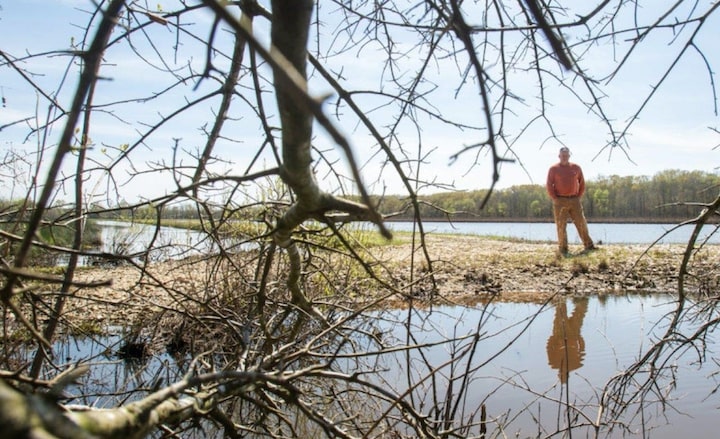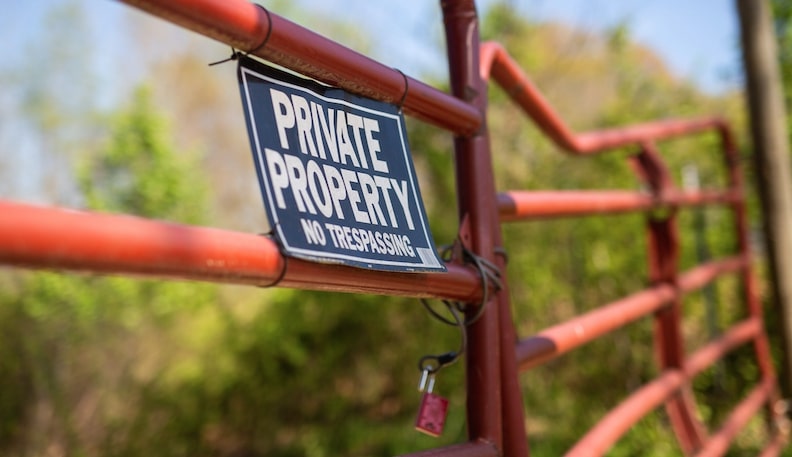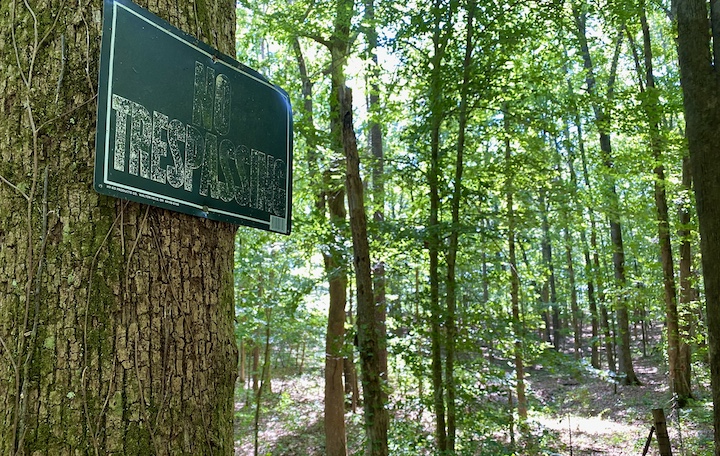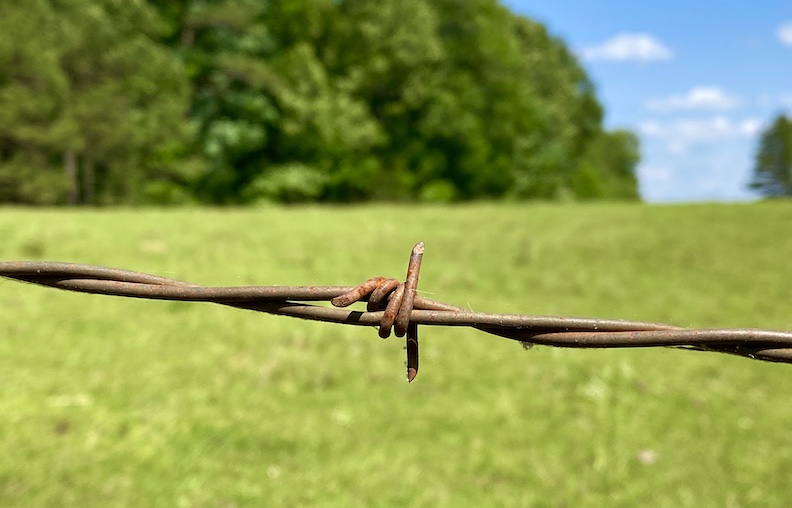Unbounded: Government Claims Right of Access and Surveillance on All Private Land

Is private land a federal playground? The government claims a phenomenally powerful right—access and surveillance on every inch of privately held farmland, hunting ground, pasture, and recreational acre in the United States, without warrant or probable cause.
The federal assertion to total power over private land is a chilling prospect to a significant portion of Americans and the alarm begs a subsequent concern: What activities does Uncle Sam assume the right to engage in after entry onto private land and precisely which government officials get a perpetual pass?
Fair warning: The uncomfortable answers arguably are a far cry from the liberty assumed by most landowners and reveal few concrete restrictions on the power of bureaucracy and government. In a word, unbounded.
The Big Blank Check
The government proclaims power to enter, surveil, and remain on private land without warrant or probable cause. A fence, gate, posted sign, no trespassing marker, and purple paint on private land are barriers to ordinary citizens, but not to the feds.

Per the Fourth Amendment, passed as part of the Bill of Rights in 1791, Americans generally bank on a guarantee of security in their “persons, houses, papers, and effects, against unreasonable searches and seizures.” However, the government contends Fourth Amendment protections do not extend to land.
Where does such sweeping authority derive? The Open Fields doctrine. Excluding residences and surrounding yards, the government’s alphabet agencies have an open door to all private land in the U.S., carte blanche, through a permanent invitation provided by the Supreme Court’s (SCOTUS ) Open Fields doctrine.
In 1924, SCOTUS erected the Open Fields framework in Hester v. United States, and declared: “the special protection accorded by the Fourth Amendment to the people in their ‘persons, houses, papers, and effects,’ is not extended to the open fields.”
Doubling down 60 years later, SCOTUS added weight to the Open Fields doctrine in 1984, Oliver v. United States: “There is no societal interest in protecting the privacy of those activities, such as the cultivation of crops, that occur in open fields.”
Therefore, according to nine black robes, the Fourth Amendment protects homes and surrounding lawns (curtilage) and immediate, adjacent structures or sheds—but nothing beyond. The realization that search and seizure protection stops at yard’s edge is a bitter pill for many Americans, says Roger McEowen, Professor of Agricultural Law and Taxation at the Washburn University School of Law.
“We’re supposed to find it reasonable for government agents to have the power to walk past and ignore a posted sign or no trespassing sign? Even ignore locked gates? Even watch you with hidden cameras without any accountability? Nobody finds this reasonable. It’s intrusive and creepy.”
“The Supreme Court says protection only applies to your house and curtilage. That’s great if you live in town, but we have a segment of society that is rural or lives in the countryside or on farms. Open Fields is wrong on so many levels,” McEowen notes. “It doesn’t even come with a footnote saying the government has to leave in five minutes or two hours or six days.”
And which federal officials or representatives have open access to private land? All of them, in theory, McEowen adds. “Fish and Wildlife, EPA, Bureau of Land Management, Corps of Engineers, and all the rest can walk on to your land. Under Open Fields, what stops EPA from walking onto any spot on your land in broad daylight and taking a soil sample or a photograph and then make you deal with the consequences? Nothing, at least according to Open Fields.”
Joshua Windham, an attorney with the Institute for Justice (IJ), a national libertarian law firm and legal advocacy group representing clients pro bono, is at the forefront of Open Fields litigation. Most Americans, he says, have never heard of the Open Fields doctrine—and are often shocked when confronted with the unchecked power it confers.
“Think of it as the government having a blank check,” Windham emphasizes. “The Open Fields doctrine says that, outside your house and its immediately surrounding yard, there is no private land in America that federal officials can’t enter as they please. None.”

“You can fence your property, stand at the front gate, and expressly tell officials not to enter your land without a warrant. But under the Open Fields doctrine, they can ignore you, force entry, spend hours patrolling your land for evidence that you’ve done something wrong—and the Fourth Amendment would have nothing to say,” Windham explains. “This sounds crazy to normal people, but that’s what the Open Fields doctrine means.”
The potential for government abuse is significant, McEowen warns. “What if your neighbor gets upset and rats you out on an alleged wetlands violation, bird baiting, or discharging water? The feds can come right in and get physical access in a manner of different ways, gather evidence, and then knock on your door and serve you papers. And what about secret camera surveillance? If you think otherwise, look at what happened in the crazy Tennessee case.”
No Warrant, No Problem
In northwest Tennessee’s Benton and Henry counties, Terry Rainwaters (136 acres) and Hunter Hollingsworth (95 acres), both own properties that serve as residence and farmland (in Rainwaters’ case), as well as hunting ground. In a two-month span between December 2017-January 2018, Rainwaters found two active Fish and Wildlife Service (FWS) trail cameras on his property, and Hollingsworth located one FWS trail camera on his private land. Without consent or warrant, the devices were installed by the Tennessee Wildlife Resources Agency (TWRA) at the behest of FWS.
Rainwaters (54) and Hollingsworth (31), represented by the aforementioned Institute for Justice (IJ), sued TWRA in 2020, and argued their land was protected by the Tennessee Constitution (Article 1, Section 7).
On March 22, 2022, in affirmation of Rainwaters and Hollingsworth, the Benton County Circuit Court declared trespassing and surveillance by TWRA game wardens on private property as illegal statewide, according to the Tennessee Constitution.

(TWRA appealed the Circuit Court decision; briefing will take place in the Tennessee Court of Appeals in fall 2022, and oral arguments likely will follow. IJ also has another pending Open Fields case involving two hunting clubs alleging private property violations by the Pennsylvania Game Commission. The hunting club case is in discovery and could proceed to summary judgement in 2022.)
Despite the Circuit Court’s ruling in Tennessee, Open Fields power remains in place for federal agencies such as FWS. Even when state constitutions (Mississippi, Montana, New York, Oregon, Vermont, Tennessee, and Washington) prevent state officials from entering and operating on private land without a warrant, federal officials function under SCOTUS’ Open Fields passport.
Considering TWRA placed surveillance trail cameras at the request of FWS on Rainwaters’ and Hollingsworth’s land, how many other warrantless cameras or surveillance technology does FWS currently have on the privately owned land of U.S. citizens? The proposition that the three cameras in Tennessee (discovered by chance by the landowners) were/are the only such warrantless devices in use by the FWS would be a hard-to-sell argument for many Americans. Snowflake in hell.
(Farm Journal contacted FWS by email and telephone regarding Open Fields. FWS did not respond.)
How much surveillance technology is in use on private land by governmental agencies other than FWS, via the Open Fields doctrine? The legal and ethical implications, and associated questions are legion. Is there a database of government-monitored past camera locations and current, active cameras? Can the government maintain presence on private land, or film via drone and photograph via trail camera for days, weeks, years?
Also, do government organizations or agencies keep tabs on the warrantless activity of their personnel on private land? A curious email sent during the Rainwaters-Hollingsworth litigation may offer a tiny clue.
Gone to Sleep
On October 6, 2020, TWRA Lieutenant Colonel Cape Taylor, Division of Boating and Law Enforcement, sent an email to six TWRA employees: Please remind the Captains that no trail cameras or similar cameras are to be deployed for use in enforcement cases, unless the use is approved by the Major. If you get a request, please contact Colonel Rider to discuss prior to approval or deployment.
However, Taylor’s email directive was sent approximately six months after Rainwaters and Hollingsworth sued. Further, in the text of the email, Taylor frames his message as a reminder (“remind”) of instruction. Yet, in his sworn deposition on April 1, 2021, Taylor testified that prior to his email, TWRA had no policy restricting officers from installing warrantless cameras on private land:
Question (IJ): But prior to—prior to your e-mail, there would have been nothing to stop a TWRA trail camera as part of their—his or her investigation; is that correct?
Answer (Taylor): There was no policy that prohibits that.
How many federal- and state-level offices and agencies have “no policy” on warrantless surveillance on private land? Considering the latitude provided by Open Fields, the answer may be alarmingly noteworthy.

“It’s absurd,” McEowen says. “We’re reached a point where we debate whether landowners can be secretly watched on their own ground with no-warrant cameras. The government doesn’t have to abide by the Fourth Amendment and we just go along? Look at the past two-and-a-half years where the government shut down private mom-and-pop businesses across the country, but allowed superstores to remain open. Stunning. As Americans, we’ve gone to sleep.”
How Goes the Farm
McEowen urges the agriculture industry to keep Open Fields on its front burner. “Agriculture must put resources into fighting this because Open Fields is as serious as it gets. I’ve got law students that have never heard of the doctrine, but they understand privacy in the home and search warrant requirements. In general, almost all of the public has zero knowledge of Open Fields.”
(For information on agriculture property, curtilage, and warrantless searches, see McEowen’s 2018 column.)
For farmers, ranchers, and landowning hunters, their acreage is almost entirely within the wide latitude of Open Fields. Even if an owner has a dwelling on the agricultural operation, the curtilage likely does not extend beyond one or two acres, leaving hundreds or thousands of acres susceptible to government presence.
“It’s ridiculous, but Open Fields is a reality for farm and ranch owners, and private landowners,” explains McEowen, author of the Agricultural Law and Taxation Blog. “There’s no way a corn field or private woods should be viewed in the same way as a sidewalk or busy street by our forefathers.”
Adios to Reasonable Suspicion
Roughly 35 years prior to the Rainwaters-Hollingsworth litigation over warrantless surveillance, in November 1983, oral arguments were held in Oliver v. United States, the landmark SCOTUS decision that provided even longer legs for Open Fields. Despite ultimately ruling in favor of Open Fields, SCOTUS justices laid bare stubborn constitutional truths when questioning Assistant Attorney General Wayne Moss, who argued in favor of Open Fields. The exchange between Moss and the justices echoes today.
Justice Byron White: So that in your view there is just nothing a landowner can do outside the house to invoke Fourth Amendment protections…If the landowner himself out there with a gun cannot keep them out or cannot create any expectation of privacy, nothing can.
Wayne Moss: That is our position, and I would like to explain that.
Justice John Paul Stevens: May I just ask, also, that doesn’t even require probable cause as I understand you.
Wayne Moss: Correct, yes.
Justice John Paul Stevens: It wouldn’t even require reasonable suspicion.
In a nutshell. Direct from the mouth of Stevens. Open Fields doesn’t even “require reasonable suspicion,” i.e., the legal threshold for the government to enter private land could not be lower.

“If you tell government officials that they have an unconditional right to enter private land, that power eventually goes to their head. They’ll act like you’re the unreasonable one for denying them entry and treat you like a criminal for standing up for your rights,” Windham says. “That sort of entitlement isn’t just dangerous—it’s part of the reason we have a Fourth Amendment in the first place. If the Amendment means anything, it’s that the government can’t just invade your property whenever it wants.”
“What a can of worms,” McEowen concludes. “How much power are we going to hand over to government? Our founders didn’t contemplate drones and cameras, but they sure contemplated property rights and privacy.”
To read more stories from Chris Bennett (cbennett@farmjournal.com), see:
Tractorcade: How an Epic Convoy and Legendary Farmer Army Shook Washington, D.C.
Bagging the Tomato King: The Insane Hunt for Agriculture’s Wildest Con Man
How a Texas Farmer Killed Agriculture’s Debt Dragon
While America Slept, China Stole the Farm
Bizarre Mystery of Mummified Coon Dog Solved After 40 Years
The Arrowhead whisperer: Stunning Indian Artifact Collection Found on Farmland
Where's the Beef: Con Artist Turns Texas Cattle Industry Into $100M Playground
Fleecing the Farm: How a Fake Crop Fueled a Bizarre $25 Million Ag Scam
Skeleton In the Walls: Mysterious Arkansas Farmhouse Hides Civil War History
US Farming Loses the King of Combines
Ghost in the House: A Forgotten American Farming Tragedy
Rat Hunting with the Dogs of War, Farming's Greatest Show on Legs
Misfit Tractors a Money Saver for Arkansas Farmer
Government Cameras Hidden on Private Property? Welcome to Open Fields
Farmland Detective Finds Youngest Civil War Soldier’s Grave?
Descent Into Hell: Farmer Escapes Corn Tomb Death
Evil Grain: The Wild Tale of History’s Biggest Crop Insurance Scam
Grizzly Hell: USDA Worker Survives Epic Bear Attack
Farmer Refuses to Roll, Rips Lid Off IRS Behavior
Killing Hogzilla: Hunting a Monster Wild Pig
Shattered Taboo: Death of a Farm and Resurrection of a Farmer
Frozen Dinosaur: Farmer Finds Huge Alligator Snapping Turtle Under Ice
Breaking Bad: Chasing the Wildest Con Artist in Farming History
In the Blood: Hunting Deer Antlers with a Legendary Shed Whisperer
Corn Maverick: Cracking the Mystery of 60-Inch Rows







